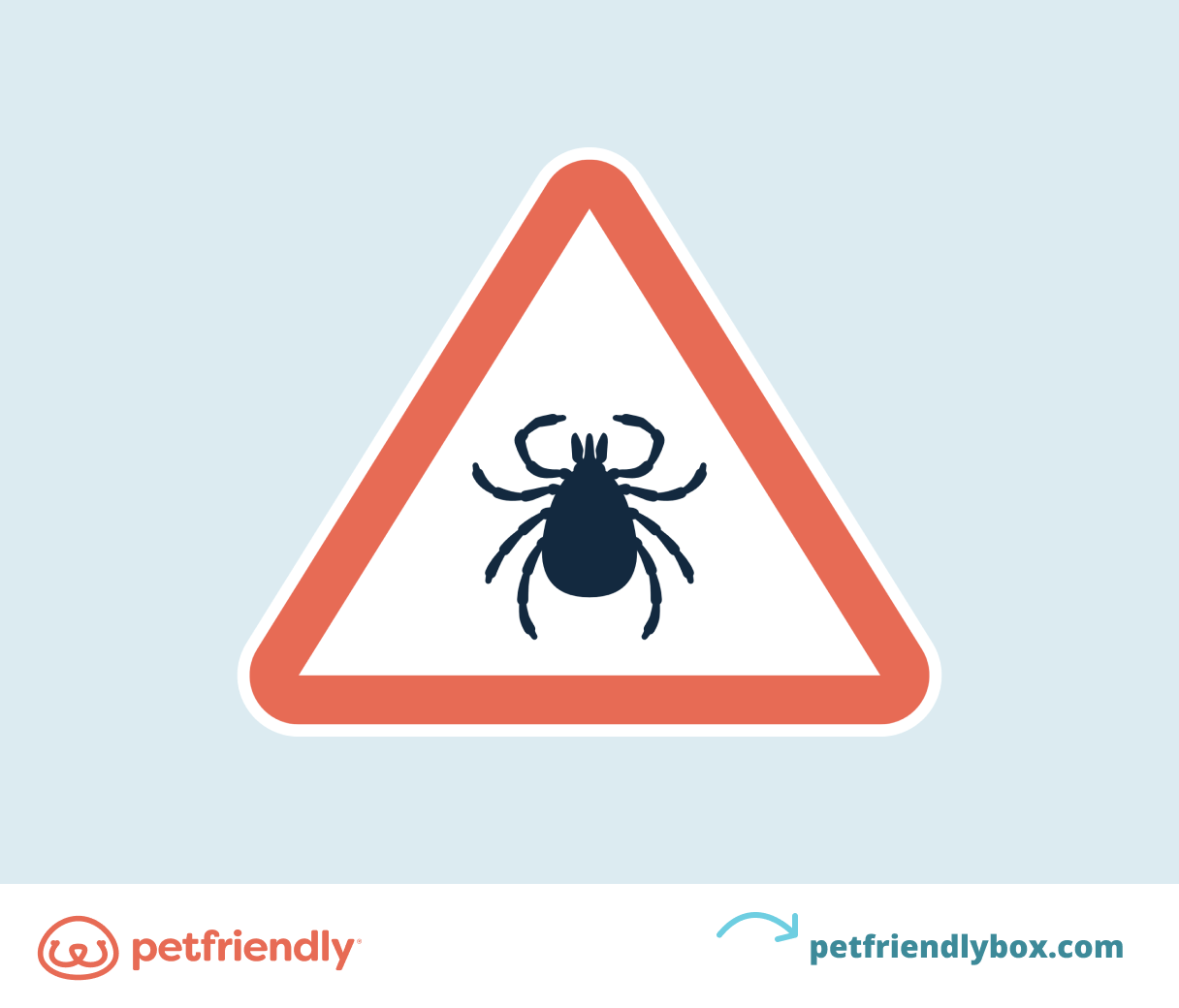Many pet parents assume that ticks are only a threat in certain states or seasons. But ticks are a big problem for dogs and people year-round.
While not all ticks spread disease, tick bites can cause severe health issues for you and your pets. As a good dog owner, it’s important to know what to expect if you find a tick on your dog. And, how to deal with the diseases they spread.
In this article, we'll share:
- Tips for identifying and treating tick bites
- The most common tick-borne diseases in dogs
- The best way to prevent ticks and tick bites

How to identify and treat a tick bite on a dog
There are a few steps you should take to treat and protect your dog from tick bites.
1. Observe your dog's behaviors.
Even with thorough inspections, it's possible to miss a tick buried in your dog's fur. Keep an eye on these common behaviors associated with tick bites:
Licking, scratching, or chewing
Anytime your pet spends extra time focusing on a specific body part, there’s likely an underlying issue. If your pup is scratching, check their skin for ticks.
Shaking head and ears
Ticks love warm, covered areas. This makes your dog’s long ear canals an ideal home. If you notice your dog is shaking their head you’ll want to take a closer look.
Low energy
You may notice a sudden change in your dog’s energy levels after a tick bite. If your typically active pup chooses nap time over playtime, check for pale gums, panting, and a loss of appetite.
2. Assess the extent of the bite.

About the size of a pinhead, making them very small, ticks are often mistaken for skin tags or cysts. If you find a tick, look closely to determine if they've embedded into your dog's skin.
An engorged tick takes on the color of the dog’s skin and may appear dark red, brown, or gray. If the infected tick has fallen off, your dog may have red, inflamed skin or scabs from the tick bite.
3. Remove the tick properly.
If you need to remove a tick, do so carefully. Grab a tick removal tool or fine-tip tweezers and a friend to help hold your dog. Get as close to your dog's skin as possible. With a gentle, but firm grip pull the embedded tick straight out.
Take a picture or drop it in a jar with alcohol. Bring it to your veterinarian if your dog develops more severe health problems.
4. Clean the infected area.
After you remove a tick, use an antiseptic like hydrogen peroxide to make sure the bite is clear of any bacteria. Dilute the antiseptic with water and carefully dab the infected area with a cotton ball or towel. Then, wash your hands in warm, soapy water and clean your supplies with isopropyl alcohol.
5. Monitor your pet for tick bite symptoms.

Even after safely removing the tick, your dog can still get infected and sick. One tick bite can wreak havoc on your pet, so keep watch for these signs and symptoms:
- Tick fever
- Wobbling or limping
- Weakness or decreased energy
- Loss of appetite or vomiting
- Swollen lymph nodes
- Coughing or difficulty breathing
- Red or glassy-looking eyes
- Warm ears and/or nose
- Panting or shivering
- Runny nose
Keep a gauge on how your dog looks and feels after a tick encounter. If their health starts to decline, be sure to visit your vet.
Tick-borne diseases in dogs

Depending on where you live, there are different tick species you might encounter. It's important to know the difference and which carries diseases that are the highest risk for your dog.
| Tick species | Tick-borne diseases |
|---|---|
| Blacklegged "deer" tick (Ixodes scapularis) | Anaplasmosis, Babesiosis, Lyme disease |
| Brown dog tick (Rhipicephalus sanguineus) | Rocky Mountain spotted fever |
| Lone star tick (Amblyomma americanum) | Ehrlichiosis |
The most common tick-borne illnesses in dogs
The danger of disease stems from the tick’s feeding process. The longer they stay, the more likely they are to feed on your pup and transmit diseases.
Here are the most common diseases spread by ticks:
Canine Lyme disease
Lyme disease is the most common tick-borne disease in the United States. Most cases come from the blacklegged tick and occur in the northeastern and upper midwestern states.
Signs of Lyme disease may not appear until 2-5 months after the initial tick bite and include:
- Lameness or stiff joints
- Difficulty breathing
- Frequent urination
Antibiotics or antiprotozoals are common treatments for most tick-borne illnesses. There is also a vaccine for Lyme disease, but you'll need to consult with your vet to choose the right treatment.
Canine Ehrlichiosis
Ehrlichiosis is an infectious disease in dogs, native to the southern states. Brown dog ticks are primary carriers, but lone star and American dog ticks can also carry the disease.
An infected dog may experience:
- Lethargy
- Weight loss
- Abnormal bleeding
- Neurological confusion
Your veterinarian will likely treat Ehrlichiosis with an antibiotic. Depending on your pet's needs they may also use a steroid to improve your dog’s condition.
Canine Babesiosis
Babesiosis is a tick-borne disease often found in southern states. The blacklegged deer tick is the most common carrier. If your dog spends time in a kennel with poor tick control, they are at a higher risk.
There is a wide range of symptoms for this disease, but the most common include:
- Dark urine
- Pale gums
- Changes in their mental state
To fight this disease, most vets will prescribe an antiprotozoal drug. They may also suggest other treatments to help with blood or fluid loss.
Canine Anaplasmosis
Anaplasma platys cause canine anaplasmosis in dogs and attacks a dog’s platelets. Blacklegged (deer) ticks are the primary carriers. This makes this disease most common on the far west coast and northeastern states.
Most dogs don’t show any signs of infection, but some noticeable ones include:
- Joint pain
- Limping
- Blindness
The best way to combat this infection is with an antibiotic. If things worsen, seek immediate veterinary attention.
Rocky Mountain spotted fever
Rocky Mountain spotted fever (RMSF) is a tick-borne illness found throughout the United States. An infectious bacteria called Rickettsia rickettsii, which causes RMSF, transmits through both nymph and adult American dog and brown dog ticks.
Symptoms of RMSF may take a while to appear and often include:
- Diarrhea
- Swelling of the face or legs
- Nosebleeds (in severe cases)
Your vet may prescribe a series of antibiotics to treat RMSF. This disease is easy to treat, especially when identified early on.
Tularemia (Rabbit Fever)
Tularemia is a tick-borne disease that is common in rabbits and small rodents and carried by American dog ticks.
Unhealthy or older dogs may experience severe problems from Tularemia, such as:
- Dehydration
- Abdominal pain
- White patches on the tongue
- Throat infection
To treat Tularemia your veterinarian may prescribe an antibiotic. This disease can also spread to humans. So, make sure you wash your hands when caring for your pets. And, visit your vet immediately for the best disease control.
Can you test for tick-borne diseases in dogs?
To find out if your pet has a tick-borne disease, your veterinarian may perform diagnostic testing. If your dog's health declines after a tick encounter, they may also order a urine or blood test.
These tests help confirm the presence of disease in your dog’s body at early stages. Your vet may also examine your pets for evidence of ticks. This will help them determine the best treatment plan.
The best way to prevent tick bites
For the health of your dog, it's important to know how to treat them if they're suffering from a tick bite. But more importantly, you can protect your pets from getting ticks in the first place.
Avoid wooded areas
If you spend time outdoors with your pup, you may run into a tick from time to time. Areas with tall grass and trees, like forests and parks, are common tick-infested areas.
Check for ticks regularly
Give your dog a thorough check for ticks after spending time outdoors, especially near tall grass. Part their fur, checking your dog for any small ticks that may be hiding. And, practice safe tick removal for the ones you can find and monitor your dog's symptoms.
Use monthly flea and tick prevention
Ticks aren’t just a summer hazard. Many ticks can survive through harsh winter conditions and indoors. Keep your pet protected all year with vet-quality flea and tick preventative.

